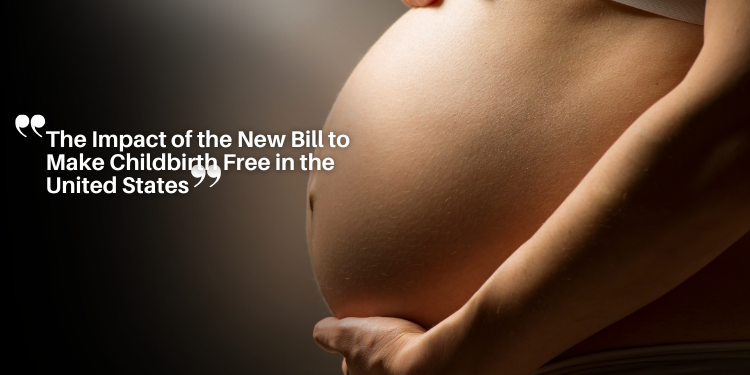The Impact of the New Bill to Make Childbirth Free in the United States

How a Bipartisan Alliance Aims to Relieve Childbirth Costs in the U.S. and Promote Maternal Health
The cost of childbirth in the United States has been a growing topic of debate, especially as birth rates decline and the financial burden on many families continues to rise.
According to recent data, families with private insurance face an average out-of-pocket cost of nearly $3,000 for childbirth.
This issue became even more apparent last month when a viral TikTok video showing a mother’s $44,000 hospital bill shocked the world, underscoring the unique financial pressures American families face when giving birth.
Now, a rare bipartisan solution could directly address at least the problem of expensive childbirth in the U.S.
The “Supporting Healthy Moms and Babies Act,” introduced in the U.S. Senate last week, proposes that private insurance companies cover all childbirth-related expenses – from prenatal care and ultrasounds to delivery, postpartum care, and mental health treatment – without any co-pays or deductibles.
Currently, Medicaid covers these costs for about 41% of U.S. births, but this proposal aims to extend the coverage to all individuals insured by private plans.
The Impact of a Bipartisan Bill for Free Childbirth
Introduced by Republican Senators Cindy Hyde-Smith (MS) and Josh Hawley (MO), along with Democratic Senators Tim Kaine (VA) and Kirsten Gillibrand (NY), the bill has garnered significant support from organizations that typically find themselves on opposite sides of the reproductive health debate.
Supporters include the American College of Obstetricians and Gynecologists, the American Medical Association, and the Association of Maternal and Child Health Programs, alongside prominent pro-life groups, including Americans United for Life, Susan B. Anthony Pro-Life America, and Live Action.
This bill has also garnered support from certain abortion rights groups.
Organizations like Unite for Reproductive & Gender Equity have expressed support, emphasizing the importance of making maternal health care and parenting more affordable for U.S. families.
While the White House has yet to comment officially, Vice President JD Vance, during his time in the Senate, had already shown support for a similar proposal, calling the idea “interesting” in 2023.
Moreover, Robert Orr, a former staffer of Vance’s who worked on the bill, now works with Senator Hawley, reinforcing the connection between Republican backers of the proposal.
| Aspect | Current System | With New Bill |
|---|---|---|
| 🧾 Coverage | Prenatal and childbirth services may involve out-of-pocket costs | Prenatal, childbirth, and postpartum care fully covered |
| 💰 Cost to Families | High and unpredictable expenses | No direct cost for maternity care |
| 📈 Insurance Premiums | Stable, but do not include full maternity coverage | Slight increase (around $30/year) |
| 🏥 Insurer Responsibility | Not required to cover all maternity services fully | Mandated to cover all maternity-related care |
| 📉 Job-Linked Coverage Risk | Loss of job can result in loss of insurance | Still a concern; not directly addressed |
The Unusual Origin of the Bill
The story behind this bill is unusual compared to most pieces of legislation in Washington, D.C., and reflects evolving factions within the anti-abortion movement.
In early July 2022, shortly after the Supreme Court overturned Roe v. Wade, Elizabeth Bruenig, a staff writer at The Atlantic, published an article urging the anti-abortion movement to take up the cause of making childbirth free.
Bruenig argued that, just as Medicare was expanded to cover dialysis and kidney transplants in the 1970s, Medicare should also be expanded to cover the costs of childbirth.
Bruenig’s proposal created a stir within the anti-abortion movement, with many figures in the movement supporting the idea.
This led to the formation of a partnership between Democrats for Life of America and Americans United for Life.
In January 2023, the two organizations released a white paper that detailed the “Make Birth Free” policy.
This white paper attracted the attention of Senator Josh Hawley, who, along with other lawmakers, began working on developing the proposed legislation.
Bruenig’s piece received a mixed reaction. Some left-wing critics saw it as insensitive, implicitly endorsing the Supreme Court’s decision to overturn Roe v. Wade and offering a right-wing solution to a deeply polarizing issue.
Bruenig, who identifies as pro-life but opposes criminal bans on abortion, explained that her goal was to provide women with a real choice, not to force them into difficult financial situations that could lead them to seek an abortion.
The Political Road Ahead
Supporters of the bill remain cautiously optimistic about its future.
The timing reflects converging forces that have created a unique window for bipartisan family policy.
Trump’s election, combined with growing concerns about declining birth rates, has contributed to a shift among some conservatives toward more proactive family policies. Meanwhile, Democrats see an opportunity to advance maternal health goals.
The bill also benefits from political cover on both sides.
Republicans can champion it as pro-family policy that potentially reduces abortions, while Democrats can support it as expanding health care access.
Crucially, because the proposal doesn’t require new government spending but instead redistributes costs through the existing private insurance system, it avoids typical conflicts over federal budget increases.
However, challenges remain. The upcoming reconciliation process will test whether Republicans prioritize fiscal restraint or family policy when forced to choose.
While Vance previously supported the idea of free childbirth, the administration faces pressure from fiscal conservatives who view any insurance mandates as market interference.
Not all conservatives will be thrilled by the idea of tinkering with the Affordable Care Act or facing accusations of supporting socialized medicine. Nevertheless, the bill has attracted support from influential conservative intellectuals.
Yuval Levin, the director of social, cultural, and constitutional studies at the American Enterprise Institute, wrote a policy brief earlier this year urging Congress to embrace making childbirth free, even if it doesn’t affect birth rates.
“Substantively and symbolically, bringing the out-of-pocket health care costs of childbirth to zero is an ambitious but achievable starting point for the next generation of pro-family policies,” he wrote.
Patrick Brown, a family policy analyst at the conservative Ethics and Public Policy Center, believes it’s “the right instinct” to share the costs of parenting more broadly across society, although he hopes it doesn’t distract from broader efforts to help parents, such as increasing the Child Tax Credit.

Conclusion
The bill to make childbirth free in the United States represents a significant shift in how the country addresses maternal health issues and the financial costs associated with childbirth.
While the proposal has unusual origins and faces several hurdles, it reflects a changing focus in U.S. public policy.
By forging bipartisan support, this bill provides an opportunity to improve the financial security of families and reduce the pressures they face when bringing a new child into the world.
If passed, this legislation could provide essential relief for families and pave the way for further reforms in family and maternal health policies.







